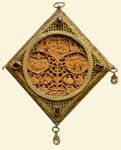|
|
| Byzantine Minor Arts |
18th c., 2nd half Protaton Wood, silver gilt and glass-paste stones 13.5 x 12 cm |
|

|
This enkolpion has a round double-sided sculpted and perforated wooden core mounted in a diamond-shaped silver-gilt frame. At the bottom of one side is the recumbent figure of the prophet Jesse, from whose body rises a vine with symmetrically curving branches terminating in medallions of different sizes. The six small medallions in the lower part of the scene, three on either side of the stem, frame prophets holding open scrolls. The larger medallions in the middle display the scenes of the Annunciation and the Transfiguration, and that at the top of the tree the Baptism, with two prophets in the smaller medallions flanking it. The same arrangement is repeated on the other side with, in the larger medallions, the Lamentation, the Anastasis and the Crucifixion, and Jonah and the whale replacing Jesse. The triangular surfaces of the frame next to the core are covered with a lacy fret of beaded wire, with red glass-paste stones in the corners adding a touch of colour. Of the three colourless stones suspended from the outer corners of the enkolpion, only two remain. In the Eastern Church the theme of the Tree of Jesse has a prophetic character, is associated with the Virgin and her role in the Incarnation, and is enriched with scenes from the liturgical calendar structured around the great events in the Life of Christ. The prophets portrayed are those who foretold the Incarnation and the redemptive sacrifice of Christ (Taylor 1980-1, pp. 165-70). The Annunciation, the Baptism and the Transfiguration, the three principal scenes pictured on one side of the enkolpion, are three epiphanies, and represent the period before the sacrifice; they correspond, that is, to the first part of the Liturgy (Hermeneia of the Liturgy 1978, pp. 13-14). The Transfiguration stresses the dual nature of Christ, with the Virgin, as the representative of the generation of the new dispensation, and John the Baptist, as the representative of the old, interceding for the salvation of mankind (Weitzmann 1990, p. 65). The sacrifice of Christ, the Crucifixion, is followed by the Lamentation and the Anastasis; these scenes, represented on the other side of the enkolpion, are associated with the second part of the Liturgy (Hermeneia of the Liturgy 1978, pp. 13-14). Opposite the Crucifixion is an allegory of the Anastasis in the figure of Jonah who, like Christ in Hades, remained for three days in the belly of the whale. The Liturgy re-enacts the Life of Our Lord, and it is natural for the officiating prelate to wear an enkolpion reflecting what is being celebrated. The Protaton enkolpion is one of a number of wooden pectorals, mostly seventeenth- and eighteenth-century work, made in monastic centres from the general Balkan area. Their iconographic programmes are closely related, and are surely susceptible to more than one reading (Taylor 1980-1, pp. 168-9. Radojkovic fig. 66. Tzaferis 1985, fig. on p. 58). The mount of this particular enkolpion, with its beaded filigree work, shares a number of structural features with other similar mounts, for crosses and pectorals, dating from about the middle of the eighteenth through the first decades of the ninettenth century (Ikonomaki-Papadopoulos 1990, p. 277, figs. 41-2).
| |
|
Bibliography: Unpublished.
| ||
| Y. I.-P. | ||
| Index of exhibits of Protato 18th century |
||
Reference address : https://www.elpenor.org/athos/en/e218ci59.asp